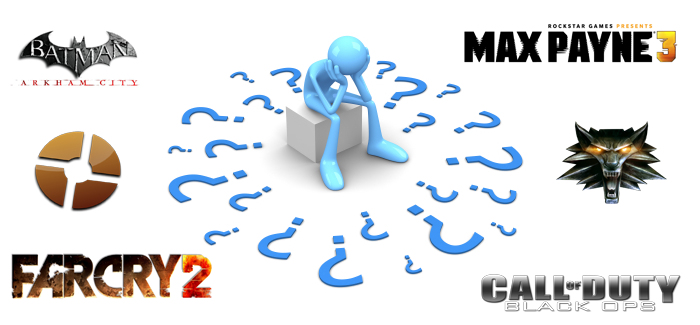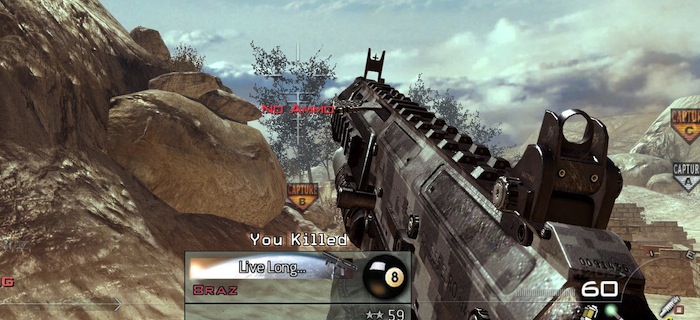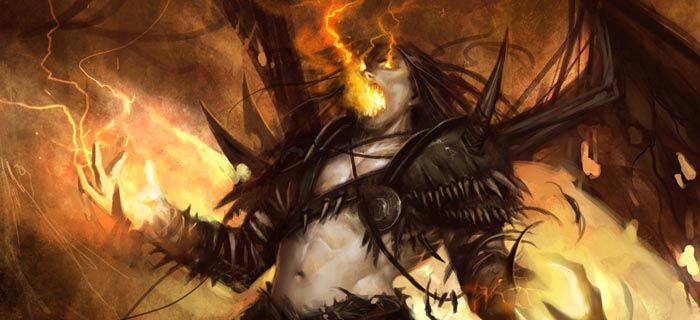Real Life Strategy: Getting the most from your collection
One of the problems I’m running into more and more these days is a troubling one. I have maybe thirty games at my disposal, on multiple platforms, and yet I do not want to play any of them. Left4Dead2, Max Payne 3, The Witcher 2, various Call of Duties (which I make no apologies for), plus a large number of games that sit, un-downloaded and collecting virtual dust. This conundrum got me thinking about how best to enjoy a large and probably ever growing collection of games you and I will probably never play.
The one-game-guy
There are those of you, I’m sure, who have one game that you play at the exclusion of all others. TF2, Assassin’s Creed, Street Fighter, whatever it is, you may’ve reached you skill ceiling, unlocked everything, and play only for the sheer joy of it. When it gets tedious, you power through until it’s fun again. Let me give you a few ideas on how to make the game new again, without needing to stray into other titles.
First and most obvious is: change the way you play. I’m a firm believer in the concept that even the most basic concepts always bear repeating. If you main spy and can out-snipe snipers with the Ambassador, try soldier. Now, prediction of enemy movement shifts from psychology to pure speed. Your knowledge how how the classes move will invariably assist you in knowing where they’ll be when you get that Kritz up. But you’ll need to learn splash damage, new ways to air-strafe, relative player speed while being juggled, etc.
If you play a twitchier shooter, like CoD or even BF3, but you use assault rifles and carbines exclusively, step out of your comfort zone and snipe. And I don’t mean for one game, or even a whole session. Do it until you unlock the last attachment, or for around 300 kills, whichever comes first. This suggestion isn’t just to make you angry at the game, though it will do that. Instead, I want you to improve in ways you might not have considered.
Sniping is all about first shot accuracy, and in the case of a miss, adaptability on the fly. For games where a sniper bullet is a one hit to most areas, it seems easier than it is. Regardless of your accuracy, you will eventually miss or the game won’t like you and there will be no kill. In the split second between the miss and your enemy turning to shoot you, the decision you make will either save or kill you. Map knowledge and awareness becomes key, since you’ll need cover and a new angle of attack. Your failures, as with anything, will teach you, and after significant practice, the hackusations just might be flying your way.
Secondly, if you don’t want to really change playstyles or character setups, try setting challenges for yourself. Some games come with a pre-baked selection, but those are often dull and repetitive. Instead, take a little time to analyze your skill set. Are you particularly good with a particular combo, are you deceptive, a good shot, keen-eyed, an escape artist? Once aware of your best areas, think of ways you can test them.
For example, if you know your vision is particularly strong, or your perception of enemy presence is sharp, try changing where you look. Run the same routes, the same items, the same moves. However, don’t focus on the main targets. Look slightly at the sky, or the top of the screen, just above your fighter’s head. Chances are, you know not only the sight but the sound of your enemy’s movements and attacks. But because your focus is elsewhere, you need to move quicker than you would otherwise to execute the same counter. By that same token, since you’ll be relying on peripheral vision and hearing for the majority of your situational awareness, those two senses must either improve or cause your failure.
Unlike my first strategy, I don’t recommend doing this for a long length of time. A couple games, or for at most an hour, will do per challenge session. Whatever you do to push your limits, you should do it only long enough to see just how far you can push yourself. Frustration is not a desired outcome, or even a necessary side effect. Challenges should be just that: challenging. But they should also be fun, a way to make the game seem new without needing to take a break for any significant period.
The girl with a few games.
Maybe you were a one-game player at one point, but now you’ve found a nice little collection to play around in. They might not be similar genres, might be on separate platforms, single and/or multi-player. Unlike the one-game-only, player, staying fresh on a single title is relatively easy. The problem comes when a new game gets announced that falls into one of your chosen genres, and you know in your heart that it will be good. You buy the game, pour a mountain of time into it, and your old games don’t measure up. In your mind, they won’t for a long time, but you want to play them, even if you don’t think you’ll have fun.
My first suggestion is quite simple. One, don’t worry about your old games too much. Play the new one into the ground, whatever that means for the particular game. Do absolutely everything there is to do, and then if need be, do it again. You’ll likely find that the new game had so much stuff in it, you’ll appreciate the simplicity of the games you left behind. If you absolutely must play your old games while the new one is still unfinished, your options are a little more varied.
You could try playing an old game in the style of the new. If the first is a twitch and the other a tactical, switch the two. If the first is a fighting and the second an RPG, again, switch the two. You’ll probably need to take it farther than just that though. Put yourself not only in the playstyle, but the mindset, of the switched genres. Play Street Fighter as though you’re looking for a lost treasure, and the person you’re fighting is the guardian. The lost treasure, in this case, is the new game. But wait! The guardian had friends, and now you need to beat them to reach your goals. You might even consider trying to talk your way into a concession victory in the lobby, roleplay style. Pretend there’s dialogue trees, or even write a couple quick options up based on your previous experience with the title.
You’re like me: too many games to play, none you want
There’s a really easy, if unintelligent, solution to this issue. Keep buying new games. Your collection will become so bloated that you won’t know which games you want to play and which games you played, hated, but will play again. It’s not good, but it works.
A more elegant solution is harder to come by. I don’t have a good one, but I can offer some ideas. The simplest, offered through via Steam, is the Favorite Games concept. Keep a list of the games you know you loved, or still love, and keep them on the back burner. Return to them when there’s nothing that sounds interesting. They won’t hold the same magic they used to, but you’ll enjoy them despite whatever faults they have.
Alternately, keep a running tab on which games you are moderately okay with, and play each of them for a couple games or about a half-hour. If by that time you aren’t having fun, switch games or switch off your system. If you’re bored out of your mind and games are the only thing you can think of to fill the void, watch some live streams. One of the interesting things about watching games is it makes you want to play them. The reason is psychological, something of a placebo effect. Because games are an interactive experience, and a live stream is passive, your mind wants to experience, not watch. Even if it’s a game you absolutely loathe, watching someone of moderate to significant skill play will fool you into thinking the game is enjoyable. Whether or not you can replicate the results of the streamer, the idea that the horrid game is tolerable, even fun, will get into your head. Even if you start playing and instantly stop, you’ve played a game that would have otherwise sat, collecting virtual dust.







“Even if it’s a game you absolutely loathe, watching someone of moderate to significant skill play will fool you into thinking the game is enjoyable. Whether or not you can replicate the results of the streamer, the idea that the horrid game is tolerable, even fun, will get into your head.”
WingspanTT and ACR multiplayer. Every. Single. Time.
He has that power. And many others, some of them I hope you never need to experience.
…oh the horror….
XIANT YOU WILL PAY FOR THIS ADMISSION.
Then you play the crap out of it and you GET GOOD!
I guess I’m kind of biased here with my high perception and good prediction of human behavior, but ACR is 75% planning what you do and 25% training to throw that twitch Smoke whenever something catches your eye.
Lately I’ve tried the process of “don’t play the go-to games (TF2, ACR, etc) until you finish at LEAST one level/chapter/area of a “new” game.
By “new” I mean “a game I bought on Steam sale 3 years ago and just installed now.”
I do this too. I make “chores” for myself.
“All right, one Act 1 run in D3 before I get to play Splinter Cell.”
I’ve enjoyed playing a personal “punishment game”. It’s simple really, whenever you die in the game, you force yourself to do something very unpleasant in the real world. Doing 50 pushups and jumping in the pool without knowing how cold it is are particularly fun. Come to think of it, it’s more like a sinister form of P90X
That’s demented, I love it. The natural extension will, of course, be “you die in the game, you die in real life.”